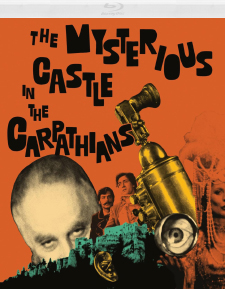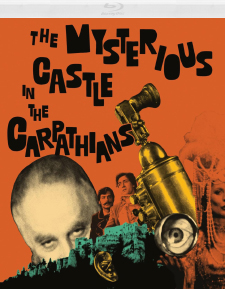Mysterious Castle in the Carpathians, The (Blu-ray Review)

Director
Oldřich LipskýRelease Date(s)
1981 (January 30, 2024)Studio(s)
Filmové studio Barrandov (Deaf Crocodile/Vinegar Syndrome)- Film/Program Grade: B-
- Video Grade: B
- Audio Grade: B-
- Extras Grade: A-
Review
The Mysterious Castle in the Carpathians (aka Tajemství hradu v Karpatech) was the third film in a loose trilogy of Czechoslovakian fantasy films that were collaborations between directors Oldřich Lipský and Jiří Brdečka, with Lipský at the helm and Brdečka serving as screenwriter. “Loose” might be a bit of an understatement, since the only thing that they really have in common with each other is the filmmakers themselves, although all three films do share a similar sense of whimsy. The first of their collaborations was Lemonade Joe (aka Limonádový Joe aneb Koňská opera) in 1964, which was highly stylized musical comedy take on the American western genre, while their 1978 follow-up Adala Has Not Had Supper Yet (aka Adéla jeste nevecerela) was a parody of American dime novel detective stories. For their final 1981 collaboration The Mysterious Castle in the Carpathians, the pair turned to France for inspiration instead, using the Jules Verne novel The Carpathian Castle (aka Le Château des Carpathes) as their source. The result was something completely different: a uniquely weird fantasy-adventure-musical that’s feels like Monty Python meets Bram Stoker, yet it’s still pure Czech fantasy.
Since Verne’s forgotten 1892 book The Carpathian Castle may (or may not) have provided some inspiration for Stoker’s Dracula in 1897, it’s probably not too much of a stretch to note the similarities. In Lipský and Brdečka’s telling, Count Felix Teleke of Tölöke (Michal Dočolomanský) is a famous opera singer who’s traveling in the Carpathian countryside accompanied by his valet Ignác (Vlastimil Brodský). They stumble across a rustic village filled with even more rustic villagers who live in fear of a nearby castle that may (or may not) be haunted. Upon further investigation, the castle turns out to be the fortress of Baron Robert Gorc of Gorcena (Miloš Kopecký), who has holed up in castle while he schemes his devilish schemes with the assistance of his servant Zutro (Augustín Kubáň) and the mad scientist Professor Orfanik (Rudolf Hrušínský). The Count and the Baron were once rivals for the hand of the late Primadona Salsa Verde (Evelyna Steimarová), and as the Count and Ignác explore the castle further, they find out that she may (or may not) be quite as dead as they had thought.
It would be easy to see the influence of Terry Gilliam in The Mysterious Castle in the Carpathians, but that would be putting the cart before the horse. At that point, Gilliam’s only forays into live action were Monty Python and the Holy Grail and Jabberwocky, with Time Bandits not reaching the theatres in 1981 until after The Mysterious Castle in the Carpathians did. The reality is that Gilliam was heavily influenced by Eastern Bloc fantasy in general and Czech animation in particular. (There wouldn’t have been a Terry Gilliam without an Alexandre Ptushko.) Brdečka, of course, was a key figure in Czech animation, and some of the elaborate retro-futuristic machinery in The Mysterious Castle was designed by legendary Czech animator Jan Švankmajer. (It’s hard not to see Švankmajer’s influence in the steampunk machinery that Gilliam created for Brazil.) Of course, it’s still possible that Lipský was aware of Giliam’s work prior to that point. The great cycle of influences is usually a circle, not necessarily a linear continuum.
Either way, the humor in The Mysterious Castle in the Carpathians is pure Lipský and Brdečka. They happily pushed whimsy into full-blown absurdity with this film, employing many visual tricks in order to maintain the motif that things are never quite what they seem in the Count’s world. There’s often a layer of irony between what’s being stated in the foreground and what’s actually visible in the background, and even when something seems like it’s being presented in relatively straightforward fashion, there’s usually a secret hiding behind it. Of course, all art is artifice no matter how much it may try to reproduce reality with any semblance of fidelity. Yet in this case, having freed themselves from any pretense toward realism, Lipský and Brdečka were able to produce a commentary on the nature of that artifice instead. The Mysterious Castle in the Carpathians is a lie about liars, told by liars, in the best possible sense of the term. As cycles of influences go, it’s easy to see a direct line between this film and Gilliam’s The Adventures of Baron Munchausen. They’re both tributes to the power of the imagination, made by imaginative filmmakers who genuinely believed in the power of the imagination.
Cinematographer Viktor Ruzicka shot The Mysterious Castle in the Carpathians on 35mm film using spherical lenses, framed open-matte at 1.37:1. Vinegar Syndrome and Deaf Crocodile describe this version simply as being a “new restoration of Mysterious Castle by Craig Rogers,” and have confirmed to us directly that no original camera negative or first-generation dupe elements were available to them. The contrast can appear flat, without a ton of detail visible in the darker areas of the frame, so the source may even have been a print. The detail can be a bit soft, too, and grain is barely visible, but no noise reduction of any kind was applied to the image. It’s just that there was only so much detail to be derived from latter generation elements. Don’t take any of that as being negative, because Rogers clearly did his best with what he had to work with, and the results are still solid. The best part is that the stylized color scheme has been preserved, ranging from deliberately muted for many of the “workaday” scenes to bursts of vivid colors for the more fantastical portions. There’s some debris visible at the edges of the frame in a few shots (something that might have been matted out in projection), but there’s otherwise no damage of note. It’s not perfect, but this is still a beautiful presentation of The Mysterious Castle in the Carpathians.
Audio is offered in Czech 2.0 mono LPCM, with removable English subtitles. It’s a generally clear track, but there is a bit of excessive sibilance in some of the dialogue, as well as a touch of distortion on a few of the peaks. That gives everything a somewhat harsh edge, but short of filtering out the high end, there’s not much that could have been done to improve it.
The Deaf Crocodile Films Blu-ray release of The Mysterious Castle in the Carpathians is packaged in a clear amaray case that displays a black-and-white still from the film on the reverse side of the insert, which is visible when the case is opened. It also includes a 20-page booklet with an essay by Jonathan Owen. There’s a spot gloss slipcover available directly from Vinegar Syndrome, limited to the first 2,000 units, that was designed by Beth Morris). The following extras are included, all of them in HD:
- Audio Commentary by Tereza Brdečková and Irena Kovarova
- Love and the Zeppelin (8:45)
- Prince Copperslick (9:39)
- Interview with Tereza Brdečková (37:38)
- Universum Brdečka (88:19)
The commentary pairs Czech film expert Irena Kovarova of the Comeback Company with author, screenwriter, and journalist Tereza Brdečková, who also happens to be the daughter of Jiří Brdečka. They provide a background for the project and how it became the third part of the trilogy of collaborations between Oldřich Lipský and Jiří Brdečka. They discuss the nature of comedy and satire in Czech film, including some of the untranslatable puns and the use of invented dialect for the townspeople. (They note some parallels between this film and the work of Wes Anderson.) They also offer some details about the production, including the difficulties in adapting this particular Jules Verne story and the challenges of working under the Communist regime in Czechoslovakia. Interestingly enough, Jiří Brdečka appears to have gone to his grave thinking that he’d written a bad screenplay for the film, so as unfortunate as that may be, at least it’s been rediscovered and reassessed over the decades since then.
The next two extras are short animated films by Jiří Brdečka that bookend his entire career. Love and the Zeppelin (aka Vzducholod a láska) is an early short from 1948 about a young woman in love with an inventor who dreams of flight, but her parents have forced her into an engagement with a dour old army general instead. Yet love (and the creative use of a flying machine) still ends up conquering all. Prince Copperslick (aka Prince Copperslick’s Thirteenth Chamber and Trináctá komnata prince Medence) was released in 1980, just two years before Brdečka passed away. Prince Copperslick is a ruddy and rotund man who eats nothing but meat, but when he falls for a pale, slender princess who eats nothing but fruit and vegetables, he’s forced to compromise. Yet he’s keeping a secret from her behind the 13th door at the end of a long hallway, and when she discovers what he’s hiding, it results in dire consequences for the Prince – and an unexpected change in lifestyle for the princess.
The Interview with Tereza Brdečková is an online conversation with the writer that’s hosted by Deaf Crocodile’s Dennis Bartok. It covers some of the same ground as the commentary track, but drills down into a bit more detail. She explains how her father and Lipský became collaborators, runs through the films that worked on together, and discusses other collaborators like Jan Švankmajer. Tereza is also front and center for the final extra on the disc, Universum Brdečka. It’s a feature-length documentary on the life of Jiří Brdečka that was produced for Czech television in 2017, directed by Miroslav Janek and written by Tereza (who also appears for on-camera interviews). While it does touch on Jiří’s work with Lipský, Universum Brdečka is a much broader look at his life and the diverse but always distinctive art that he created.
In fact, the addition of Universum Brdečka to an already fine slate of extras makes Deaf Crocodile’s release of The Mysterious Castle in the Carpathians feel more like a double feature. The whole package is still worth picking up for Mysterious Castle alone, but for fans of Czech cinema, the inclusion of Universum Brdečka makes this release a must-buy. Highly recommended.
- Stephen Bjork
(You can follow Stephen on social media at these links: Twitter and Facebook.)

